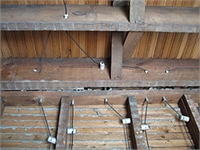
The Dangers of “Back Feeding “
Important Notice: Our web hosting provider recently started charging us for additional visits, which was unexpected. In response, we're seeking donations. Depending on the situation, we may explore different monetization options for our Community and Expert Contributors. It's crucial to provide more returns for their expertise and offer more Expert Validated Answers or AI Validated Answers. Learn more about our hosting issue here.

The Dangers of “Back Feeding “
You must be logged in to post a comment.
Many people, especially those living in rural and remote area have fixed standby generators hooked into their service panel through a transfer switch for use in case of power outages. Many people living in the city and suburbs have smaller, portable, standby generators for the same purpose. The problem with portable, standby generators is that they have no permanent hookup to the service panel through a transfer switch. Portable generators come with receptacles for cord and plug connected appliances, and tools with the appliance or tool plugged directly into the generator. Many people make up a cable with two male plugs to connect the portable, standby generator into their house’s electrical system and "Back Feed" their house’s service panel. Back feeding the service panel is a direct violation of the National Electrical Code (NEC) and a direct violation of all local electrical codes.
Back Feeding Power Into The Power Grid
Many people forget to shut off the main service disconnect circuit breaker before plugging their portable, standby generator into a convenient electrical outlet. Back feeding the power grid is extremely dangerous. Your generator endangers electricians working on downed electric wires. Reverse feeding secondary distribution transformers transforms your generator’s 115/230-volt output to 2300 volts or more. By back feeding power into the grid, you can cause linemen serious injury or even cause their death by electrocution.
Back Feeding Is A Potential Fire Hazard
Even if, you disconnect your home from the power grid by turning off the main service disconnect, back feeding is dangerous. Back feeding your service panel can easily overload a portable, standby generator and destroy it in a short period. Most portable, standby generators have an output of 4 Kilowatts (KW) or lower, nowhere near enough to power all the electrical loads in a typical home. Overloading the generator will cause it and the wires connecting it to the service panel to overheat. The wires will get hot enough to start a fire before the generator is destroyed. Portable, standby generators are only capable of handling a few essential loads.
Danger Of Electrocution
Connecting a portable, standby generator using a cable with two male plugs increases of electrocution for yourself and increases the risk of electrocution for your family members. Unplugging the generator’s cable from the receptacle outlet before unplugging it from the running generator will expose you to the energized blades on the generator’s cable’s plug.
Use Your Portable, Standby Generator Safely
Protect yourself, your loved one, your property, and the unsuspecting utility workers, connect your portable, standby generator in the correct way. Install a manual transfer switch and an essential loads sub panel. Install them yourself or have them installed by a licensed electrician if you do not feel that you are qualified to do the job yourself.
I will discuss transfer switches in my next column and essential loads sub panels in the following column.